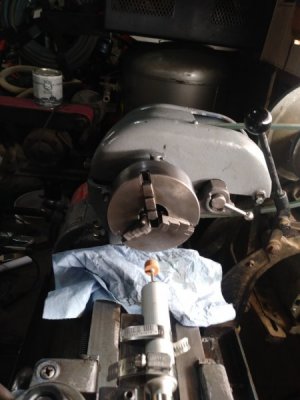-
Welcome back Guest! Did you know you can mentor other members here at H-M? If not, please check out our Relaunch of Hobby Machinist Mentoring Program!
You are using an out of date browser. It may not display this or other websites correctly.
You should upgrade or use an alternative browser.
You should upgrade or use an alternative browser.
Jaw grinding
- Thread starter fkrel
- Start date
- Joined
- Jun 7, 2013
- Messages
- 10,450
To achieve a satisfactory job of jaw grinding, it is necessary to restrain the jaws as they are tightened inwards; on one small lathe, I drilled the face of the jaws at the smallest step with a carbide drill and chucked down on a steel ring sized big enough to allow the grinding wheel to enter the jaws. There are other ways of achieving this.
I cut this plate for my 4 jaw on my first lathe.
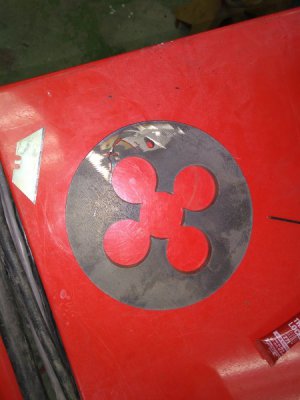
Installed
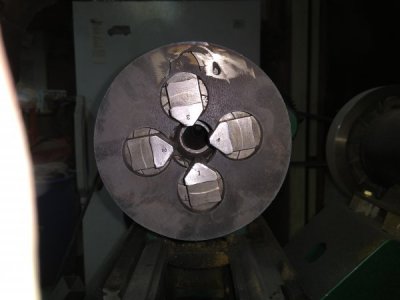
worked good, these jaws were so worn that a rod could be moved after it was tightened down, get it indicated in bump it and it was out by .010-.020 Grinding it made it much better, actually usable.
Could do a 4 hole version for a 3 jaw chuck.

Installed

worked good, these jaws were so worn that a rod could be moved after it was tightened down, get it indicated in bump it and it was out by .010-.020 Grinding it made it much better, actually usable.
Could do a 4 hole version for a 3 jaw chuck.
- Joined
- Jun 7, 2013
- Messages
- 10,450
This device works well with 3 jaw chucks too, thanks for posting the picture. It works especially well for 3 jaw chucks that do not have two piece jaws, for them, one can cut short sections of allen wrench that extend past the allen bolts used to secure the top jaws, and chuck down on a ring of A diameter that will allow the grinding wheel to enter the jaws.
- Joined
- Feb 1, 2015
- Messages
- 9,985
Another version of the grinding fixture.
https://www.hobby-machinist.com/threads/grinding-my-jaws.50747/
https://www.hobby-machinist.com/threads/grinding-my-jaws.50747/
Another version of the grinding fixture.
https://www.hobby-machinist.com/threads/grinding-my-jaws.50747/
Very similar, I cut mine on the plasma table and made the tool holder out of aluminum
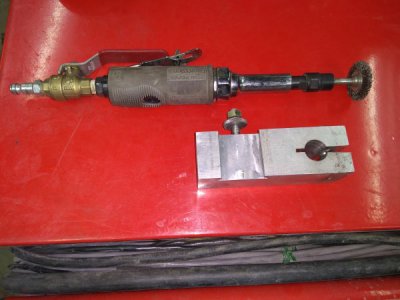
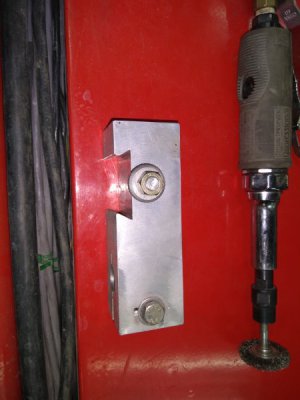
I used the long nose air die grinder from Horrible Freight, just zip tie the trigger lever and use the ball valve to control the speed.
- Joined
- Dec 25, 2011
- Messages
- 10,552
I have read numerous threads on re-grinding chuck jaws on this and other sites, and seen not a few videos on places like U-Tube. I have yet to see the first time that anyone mentions that regardless of how you pre-load the jaws, none of these methods are capable of returning the jaws to like new condition. If you look at the holding end of a new or nearly new jaw, you will see that the surface of the jaw is flat, and in a plane that is exactly perpendicular to the direction in which the jaw moves as it is being tightened. If you look at one that has been re-ground using any of these methods, you will see that it is concave. If you then close the chuck on a work piece whose radius is smaller than or exactly equal to the radius at which the final grinding took place, you will have line contact between the the three jaws and the work piece, and every thing is fine. But if the work piece is larger than that radius, you will have two lines of contact between each jaw and the work piece. And as the jaws are hard and the corner is sharp, there is a good chance of marking the surface of the work piece. And the reground jaws will have a shorter service life than they did the first time around.
The only way to re-grind the jaws so that they look and work as when new is to be able, after completing the grinding while rotating the spindle, to then be able to move the grinder vertically while grinding exactly at 9:00 or to move it down and do the additional grinding exactly at the 6:00 position, while moving the cross slide. This also requires having a method to adjust and then lock the chuck at exactly 09:00 or 06:00. Unfortunately, using the indexing pin is not an option as with the threaded spindle nose, there is only about one chance in 360 of a hole being in the exactly right location. Making a clamp that would lock the chuck in the correct position would be doable if not easy. But properly positioning the jaw for the flattening grind wouldn't be trivial.
The only way to re-grind the jaws so that they look and work as when new is to be able, after completing the grinding while rotating the spindle, to then be able to move the grinder vertically while grinding exactly at 9:00 or to move it down and do the additional grinding exactly at the 6:00 position, while moving the cross slide. This also requires having a method to adjust and then lock the chuck at exactly 09:00 or 06:00. Unfortunately, using the indexing pin is not an option as with the threaded spindle nose, there is only about one chance in 360 of a hole being in the exactly right location. Making a clamp that would lock the chuck in the correct position would be doable if not easy. But properly positioning the jaw for the flattening grind wouldn't be trivial.

